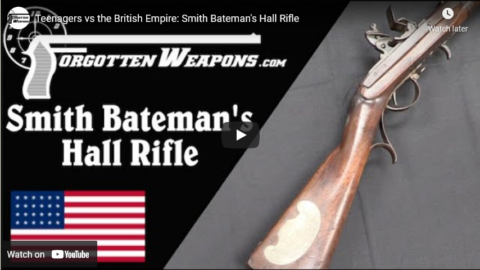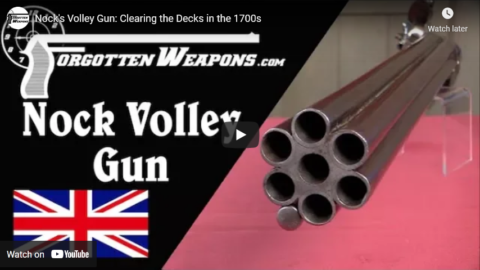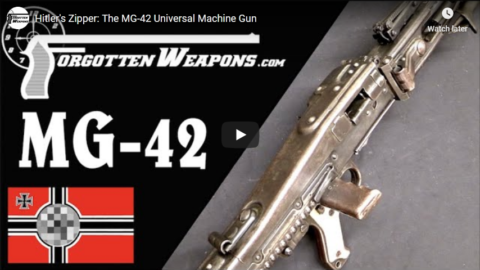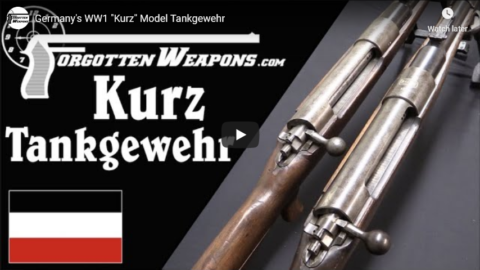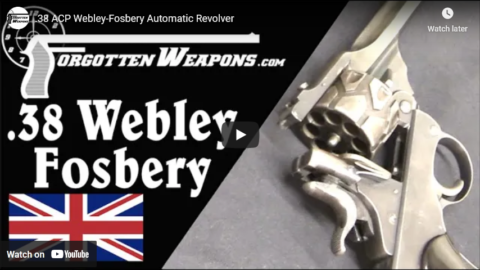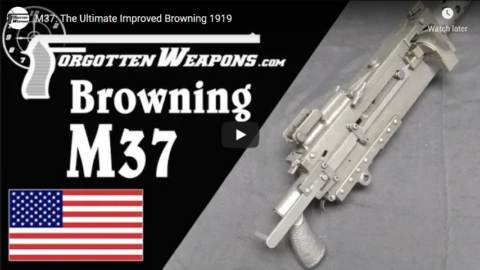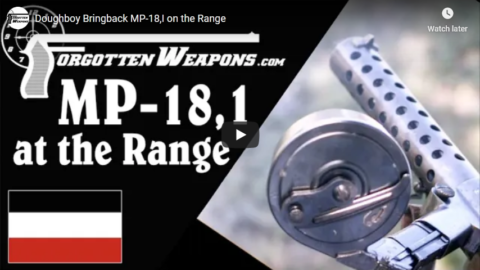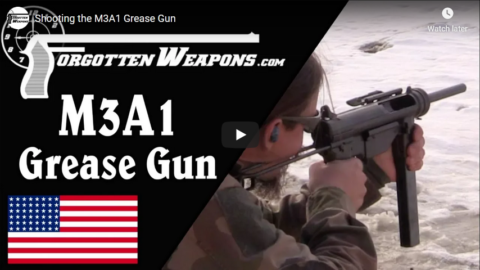Forgotten Weapons
Published 4 Dec 2020http://www.patreon.com/ForgottenWeapons
https://www.floatplane.com/channel/Fo…
Cool Forgotten Weapons merch! http://shop.bbtv.com/collections/forg…
Combat experience with the bazooka rocket launcher in World War Two and its larger versions in the Korean War convinced the US military that a better weapon was needed to give front-line troops a direct-fire way to attack enemy strong points. The bazooka was bulky, not particularly accurate, and created a lot of backblast signature when fired. This led to a multi-part development effort involving design of a small grenade body, reliable but cheap fusing system, and a cartridge design that could launch it.
The result was the 40x46mm grenade. It uses a “high-low” system (originally developed by Rheinmetall during World War Two) in which a powder charge is fired in a small compartment within the cartridge case. The initial pressure in this compartment is some 35,000 psi, which is plenty high to ensure complete and repeatable powder burn. At peak pressure, the internal compartment ruptures, allowing the propellant gasses to expand into the full case volume, which lowers the pressure to about 3,000 psi. This lower pressure is safe to use with an aluminum barrel, and propels the grenade at about 250 fps, giving it a range of about 400 yards without generating excessive recoil.
The M79 proved to be very accurate and reliable. Its downside was the need for the grenadier to carry a backup sidearm, as the M79 could not be used at close range. Almost as soon as it was introduced, work began on developing a launcher which could be attached to the M16 service rifle. This would first be the XM-148, and then ultimately the M203 that would replace the M79 in service. M79 launchers can still be found all over the world, however, as they are robust and reliable.
Contact:
Forgotten Weapons
6281 N. Oracle #36270
Tucson, AZ 85740
March 8, 2021
M79: The Iconic “Bloop Tube” 40mm Grenade Launcher
March 4, 2021
Teenagers vs the British Empire: Smith Bateman’s Hall Rifle
Forgotten Weapons
Published 24 Nov 2020http://www.patreon.com/ForgottenWeapons
https://www.floatplane.com/channel/Fo…
Cool Forgotten Weapons merch! http://shop.bbtv.com/collections/forg…
On May 20, 1826 the United States Congress formally presented Model 1819 Hall rifles with personalized silver plaques to the 20 members of Aikin’s Volunteers, for their “Gallantry at the Siege of Plattsburg”. The Volunteers were a group of 20 boys, aged 14-17, from the Plattsburg Academy who joined up under 21-year-old Martin Aikin to help in the Defense of Platssburg during the British Invasion in 1814. The boys acted as valuable scouts in the days leading up to the battle, and on the main day of fighting they manned positions at a mill on the Saranac River, preventing British troops from crossing under rifle fire. The American General Macomb commended the boys’ contribution to the battle, and promised each a rifle as a token. Of thanks. It would take Congress 14 years to fulfill that promise, but they finally did in 1826, with the only rifles ever presented to civilians by Congress before or since.
Contact:
Forgotten Weapons
6281 N. Oracle #36270
Tucson, AZ 85740
March 1, 2021
Solothurn S18-1000: The Pinnacle of Anti-Tank Rifles
Forgotten Weapons
Published 13 Oct 2017Among all the antitank rifles developed between the World Wars, the highest quality and most sophisticated was the Solothurn S18-1000. It fires the 20x138B cartridge which was also used in the Finnish Lahti L-39 and the German 20mm Flak guns, and it does so using a semiautomatic action and an 8-round box magazine. It is a short-recoil system, with a rotating bolt rather similar to that of the MG-34 machine gun.
The recoil-operated action of the Solothurn helps dampen its recoil more than the Lahti, and is definitely a more comfortable gun to shoot. The Solothurn is equipped with both iron sights and an optical sight (we used the irons in this shooting, because the rubber eye cup on the scope is fairly hard and brittle on this example). Remarkably for its 100+ pound weight, the gun definitely jumps back a few inches when fired unless one has firmly sunk the bipod feet into the earth. However, the recoil force is really more of a push than a sharp impact, and combined with the large surface area of the shoulder pad it is not at all a bad experience.
A number of different countries bought the S18-1000 (and many others bought the smaller S18-100), including the Italians and Hungarians. The only combat account I was able to find was from a Dutch antitank gun team that used one to successfully engage several German armored cars during the invasion of the Netherlands in 1940.
http://www.patreon.com/ForgottenWeapons
Cool Forgotten Weapons merch! http://shop.bbtv.com/collections/forg…
If you enjoy Forgotten Weapons, check out its sister channel, InRangeTV! http://www.youtube.com/InRangeTVShow
February 26, 2021
Germany’s First Smokeless Carbines: the Kar 88 and Gewehr 91
Forgotten Weapons
Published 27 May 2018http://www.forgottenweapons.com/germa…
http://www.patreon.com/ForgottenWeapons
Cool Forgotten Weapons merch! http://shop.bbtv.com/collections/forg…
With the development of the smokeless Gewehr 88 “Commission Rifle”, the German Army finally made a serious effort to bring their cavalry units up to a modern standard. There had never been a carbine variant of the Mauser 71/84 produced, and even by the late 1880s many German cavalrymen were still carrying single shot Mauser 71 carbines — or worse, converted captured Chassepots from the Franco-Prussian War. While the Karabiner 88 wasn’t in production quite as quickly as they would have liked, guns were coming off the factory line in quantity by the summer of 1890. The factories tasked with this production were not actually the major state arsenals, but rather two private companies in Suhl — CG Haenel and VC Schilling (although the Erfurt Arsenal would step in in 1891 to make a batch of 25,000 carbines).
The Kar 88 was remarkable light and handy, and designed for use in a cavalry scabbard, meaning that it had a nice slick profile. This became a problem when the Army wanted to issue the carbines for foot artillery crews as well, because it gave them no way to stack the rifles while tending to their artillery pieces. The result was the Gewehr 91, which was identical to the Kar 88 in every way except for the addition of a stacking rod under the muzzle.
Both the Kar 88 and Get 91 were already being slowly taken out of service before World War One, as the new Mauser 98 pattern carbines introduced in 1909 or 1910 were taking their place. This would change with the outbreak of war, of course, and every one of the 88 pattern carbines in German inventory would be issued out during the Great War. Their size and weight made them ideal for the troops who needed a personal weapon but were unlikely to actually have to fight with it (artillery crews, cyclists, supply drivers, balloon crews, etc). After the war, they all disappeared from military service, though. The arms limitations of the Treaty of Versailles gave Germany no reason to keep obsolescent arms, and they were discarded in favor of keeping Mauser 98 pattern rifles and carbines.
Contact:
Forgotten Weapons
6281 N Oracle #36270
Tucson, AZ 85704
February 22, 2021
The Best BAR: Luxembourg .30-06 FN-D at the Range
Forgotten Weapons
Published 17 Nov 2020http://www.patreon.com/ForgottenWeapons
https://www.floatplane.com/channel/Fo…
Cool Forgotten Weapons merch! http://shop.bbtv.com/collections/forg…
I normally want to have something specific to demonstrate when I take a gun to the range, but today I don’t. What I have today is and FN-D, the very best iteration of the Browning Automatic Rifle (BAR) — and I just wanted an excuse to take it out to enjoy. Specifically, this is a Luxembourg contract FN-D chambered for .30-06. So, please pardon my flimsy excuse, and enjoy!
Contact:
Forgotten Weapons
6281 N. Oracle #36270
Tucson, AZ 85740
February 19, 2021
Krupp 50mm Mountain Guns for Siam (Thailand)
Forgotten Weapons
Published 16 Nov 2020http://www.patreon.com/ForgottenWeapons
https://www.floatplane.com/channel/Fo…
Cool Forgotten Weapons merch! http://shop.bbtv.com/collections/forg…
Edit: The three interlocking rings are Krupp’s logo, not a Thai property mark — sorry!
In 1906, Siam (now Thailand) purchased a batch of 50mm mountain guns from Krupp of Germany. These were simple fixed-barrel guns with steel-belted wooden wheels. Designed to be carried by elephant, mule, or even soldiers, the guns disassemble into a number of man-portable pieces. Two different styles of rear sight were used, although it is unclear when one replaced the other. Today, these guns are a great choice for the cannon enthusiast as they have been specifically exempted from the NFA and thus transfer like any simple firearm (no tax stamp required).
Contact:
Forgotten Weapons
6281 N. Oracle #36270
Tucson, AZ 85740
February 15, 2021
Gewehr 71/84: Germany’s Transitional Repeating Rifle
Forgotten Weapons
Published 10 Jun 2018http://www.forgottenweapons.com/geweh…
http://www.patreon.com/ForgottenWeapons
Cool Forgotten Weapons merch! http://shop.bbtv.com/collections/forg…
In the ongoing arms race between France and Germany, the Mauser 71/84 was the first German repeating rifle. Paul Mauser began work on it in the late 1870s, patented the design in 1881, and it was adopted formally in 1884. Production began in 1885, with a total of 1,161,148 rifles being delivered by the four major state arsenals (Spandau, Amberg, Erfurt, and Danzig) by 1888 — when it was replaced by the Gewehr 88. With an 8-round tube magazine under the barrel, the 71/84 represented a substantial increase in firepower over the single-shot Mauser 71 and the French 1874 single shot Gras — but it was put into production just in time to be rendered obsolete by the Lebel and its smokeless powder cartridge in 1886.
The 71/84 was perhaps the German rifle with the shortest service life, at barely 5 years. It would come back out as a reserve rifle during World War One, of course, and it also was responsible for a change in German arms that would last all the way to the present day — the pull-through cleaning kit. The tubular magazine made it impossible to leave a cleaning rod under the barrel as on the Gew71, and rather than put it on the side like the French and Portuguese, Germany opted to remove it entirely in favor of the then-new pull-through cleaning kit.
If you enjoy Forgotten Weapons, check out its sister channel, InRangeTV! http://www.youtube.com/InRangeTVShow
February 12, 2021
Nock’s Volley Gun: Clearing the Decks in the 1700s
Forgotten Weapons
Published 3 Mar 2018The Nock Volley Gun was actually invented by an Englishman named James Wilson in 1789, and presented to the British military as a potential infantry weapons. This was declined as impractical, but the Royal Navy found the concept interesting for shipboard use. In 1790 the Navy ordered two prototypes made by the British gunsmith Henry Nock, and finding them suitable, proceeded to oder a total of 500 of the guns (thus forever associating Nock’s name with the gun instead of Wilson’s). A further 100 or so were ordered in 1797, and the guns were in fact issued out to various ships — although accounts of their use in combat are difficult to find.
Unfortunately for Nock, the guns presented a couple of substantial problems in use. One was simply the recoil of firing. A single 32-bore (approximately .55 caliber) round ball over 40 grains of black powder is not a very impressive load, but seven of them firing simultaneously add up to a recoil comparable to 4- or 6-bore rifles, and in a volley gun weighing just 13 pounds (5.9kg). In addition, the guns did not always reliably fire all barrels, especially when dirty. This produced a conundrum: how to determine which barrels had fired and which had not? The practical result was double-loaded barrels, which could be liable to bulge or burst. For these reasons, the weapon was declared obsolete in 1805, and never appeared to play any significant military role.
The gun did receive a new wave of popular awareness in 1960, when the character of Jim Bowie was outfitted with one in the movie The Alamo (against all historical evidence). His easy handling of the weapon and the waves of men he was able to mow down with it brought the gun back into the popular consciousness.
http://www.patreon.com/ForgottenWeapons
Cool Forgotten Weapons merch! http://shop.bbtv.com/collections/forg…
If you enjoy Forgotten Weapons, check out its sister channel, InRangeTV! http://www.youtube.com/InRangeTVShow
Contact:
Forgotten Weapons
6281 N Oracle #36270
Tucson, AZ 85704
February 6, 2021
Hitler’s Zipper: The MG-42 Universal Machine Gun
Forgotten Weapons
Published 4 Nov 2020http://www.patreon.com/ForgottenWeapons
https://www.floatplane.com/channel/Fo…
Cool Forgotten Weapons merch! http://shop.bbtv.com/collections/forg…
The MG42 was developed to be a more reliable and easier to manufacture replacement for the MG34, although both would serve side by side until the end of World War Two. Designed by Grossfuss company engineer Werner Gruner with no previous military or small arms design experience, the MG42 used heavy stampings for its main assemblies, thus reducing German need for expensive and difficult to obtain alloyed steels.
As a practical matter, the MG42 had a much higher rate of fire than the MG34, at 1500-1600 rounds per minute (more than 50% faster than the MG34). This was deemed desirable to improve the effectiveness of suppressing fire and the density of the cone of fire, but naturally resulted in much higher ammunition consumption than other machine gun models.
This example is a very early production Gustloff example, with the early horizontal charging handle, unreinforced wooden stock, and adjustable front sight. It was most likely captured in North Africa from Rommel’s forces, as they were a primarily user of the very early MG42s.
Contact:
Forgotten Weapons
6281 N. Oracle #36270
Tucson, AZ 85740
February 3, 2021
Germany’s WW1 “Kurz” Model Tankgewehr
Forgotten Weapons
Published 29 Oct 2020http://www.patreon.com/ForgottenWeapons
https://www.floatplane.com/channel/Fo…
Cool Forgotten Weapons merch! http://shop.bbtv.com/collections/forg…
When the German Tankgewehr was introduced in May 1918, the first 300 or so guns were of a different pattern than the standard production that would follow (and of which about 16,000 would be made). The Kurz model had a barrel about 4 inches shorter than the standard, and was about 2 pounds heavier, because that barrel (although shorter) was much larger in diameter than the standard pattern.
Contact:
Forgotten Weapons
6281 N. Oracle #36270
Tucson, AZ 85740
February 2, 2021
.38 ACP Webley-Fosbery Automatic Revolver
Forgotten Weapons
Published 11 Nov 2020http://www.patreon.com/ForgottenWeapons
https://www.floatplane.com/channel/Fo…
Cool Forgotten Weapons merch! http://shop.bbtv.com/collections/forg…
The rarest variation of the Webley-Fosbery automatic revolver is the .38 ACP model. Only 341 of these were made by Webley, in an attempt to compete with the new semiautomatic pistols appearing on the market — most notably the Colt Model 1900 and Model 1902. The Colt was chambered for .38 ACP, a remarkable cartridge for its time — high velocity and semi-rimmed. Webley figured that an 8-shot Fosbery-type revolver would offer the same capacity and ballistics as the new Colt, but in a revolver format familiar to the British market. The design could load cartridges individually, but also offered use of an 8-shot moon clip. Unfortunately for Webley, British legislation in 1903 hampered civilian handgun ownership and the military was not interested at all because the bore was too small. Of the 341 originally made, some were finally converted to .455 caliber after years of sitting unsold in Webley’s warehouse.
This model makes a notable appearance in Dashiell Hammett’s novel The Maltese Falcon, which quite specifically identifies it as an 8-shot, .38 caliber Webley-Fosbery. In the movie version, Humphrey Bogart mistakenly says it is an 8-shot .45, however…
Contact:
Forgotten Weapons
6281 N. Oracle #36270
Tucson, AZ 85740
January 31, 2021
M37: The Ultimate Improved Browning 1919
Forgotten Weapons
Published 8 Mar 2019http://www.patreon.com/ForgottenWeapons
Cool Forgotten Weapons merch! http://shop.bbtv.com/collections/forg…
In November of 1950, the US Ordnance Department requested an improved version of the Browning 1919 air-cooled machine gun for use in tanks. The new version was to be able to feed from either the left or right, a feature which was unimportant for an infantry gun but much more relevant when mounting guns into the tight spaces of an armored vehicle. An interim conversion of existing guns to the M1919A4E1 pattern came first, followed by manufacture of all-new guns by the Rock Island Arsenal and Saco-Lowell company from 1955 until 1957.
The design of the gun fell to Bob Hillberg at High Standard. He came up with a clever set of reversible plugs to change the bolt between left and right hand feed, as well as a captive recoil spring, manual safety, improved top cover and rear cover latches, and several other strengthened parts. He also incorporated a charging handle extension with integral manual hold open and a link ejection chute that could be mounted to either side of the gun. His T153 design was formally adopted as the M37, in caliber .30-06. A 7.62mm NATO version (the M37E1) followed as well. The M37 would serve into the late 1960s on the M48 and M60 tanks as well as several helicopters.
Contact:
Forgotten Weapons
PO Box 87647
Tucson, AZ 85754
January 28, 2021
Doughboy Bringback MP-18,I on the Range
Forgotten Weapons
Published 21 Oct 2020http://www.patreon.com/ForgottenWeapons
https://www.floatplane.com/channel/Fo…
Cool Forgotten Weapons merch! http://shop.bbtv.com/collections/forg…
The MP-18,I was most likely the first true submachine gun to see combat use, issued in the final months of World War One to German Sturmtruppen. These guns were originally fitted with 32-round drum magazines form the Artillery Luger, but they were almost all quickly changed to standard System Schmeisser box magazines shortly after the war ended. This is a rare example of one still in its original configuration, as brought home by a US soldier as a war trophy.
The MP-18,I set the standard for basically all future SMGs. It has remarkably gentle to shoot, with a low rate of fire and nice big sights. The drum does throw the balance substantially off to the left side, but it has few other serious problems.
Contact:
Forgotten Weapons
6281 N. Oracle #36270
Tucson, AZ 85740
January 25, 2021
Evolution of the Submachine Gun: Three Distinct Generations
Forgotten Weapons
Published 20 Oct 2020http://www.patreon.com/ForgottenWeapons
https://www.floatplane.com/channel/Fo…
Cool Forgotten Weapons merch! http://shop.bbtv.com/collections/forg…
Submachine guns have gone through a distinct evolution over the past one hundred years. Today we will look at these changes, specifically identifying:
– 1st Generation guns from World War One and through the 1930s
– 2nd Generation guns of World War Two
– 2nd Generation guns after World War Two
– 2nd Generation guns adapted to modern polymer manufacturing
– 3rd Generation guns in the form of rifle actions scaled down to pistol calibers
January 22, 2021
Shooting the M3A1 Grease Gun
Forgotten Weapons
Published 9 Mar 2018The M3 (and its followup improved M3A1 model) was the United States’ answer to the high cost and manufacturing complexity of the Thompson submachine gun. The M3 “Grease Gun” (because really, that is what it looks like) was a very inexpensive weapon with a stamped and welded receiver and only a few milled parts. It also had the slowest rate of fire of any World War 2 submachine gun at about 450 rounds/minute. Its weight, compactness, and controllability made it almost universally preferred over the Thompson, at least by soldiers who had to carry and fight with either of them.
The Grease Gun is reputedly extremely controllable because of its low rate of fire, but this is my first time to actually try shooting one. Will it live up to that reputation?
http://www.patreon.com/ForgottenWeapons
Cool Forgotten Weapons merch! http://shop.bbtv.com/collections/forg…
If you enjoy Forgotten Weapons, check out its sister channel, InRangeTV! http://www.youtube.com/InRangeTVShow
Contact:
Forgotten Weapons
6281 N Oracle #36270
Tucson, AZ 85704

